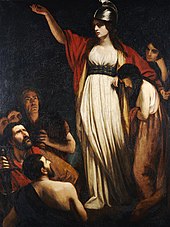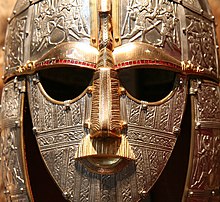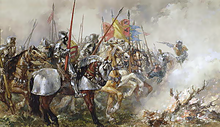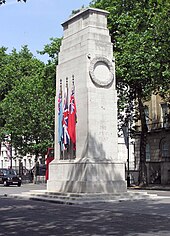England  i/ˈɪŋɡlənd/
i/ˈɪŋɡlənd/ is a
country that is
part of the
United Kingdom.
[6][7][8] It shares land borders with
Scotland to the north and
Wales to the west; the
Irish Sea is to the north west, the
Celtic Sea to the south west, with the
North Sea to the east and the
English Channel to the south separating it from
continental Europe. Most of England comprises the central and southern part of the island of
Great Britain in the
North Atlantic. The country also includes
over 100 smaller islands such as the
Isles of Scilly and the
Isle of Wight.
The area now called England was first inhabited by modern
humans during the
Upper Palaeolithic period, but it takes its name from the
Angles, one of the
Germanic tribes who settled during the 5th and 6th centuries. England became a unified state in AD 927, and since the
Age of Discovery, which began during the 15th century, has had a significant cultural and legal impact on the wider world.
[9] The
English language, the
Anglican Church, and
English law—the basis for the
common law legal systems of many other countries around the world—developed in England, and the country's
parliamentary system of government has been widely adopted by other nations.
[10] The
Industrial Revolution began in 18th-century England, transforming its society into the world's first
industrialised nation.
[11] England's
Royal Society laid the foundations of modern experimental science.
[12]
England's terrain mostly comprises low hills and plains, especially in central and southern England. However, there are uplands in the north (for example, the mountainous
Lake District,
Pennines, and
Yorkshire Dales) and in the south west (for example,
Dartmoor and the
Cotswolds).
London, England's
capital, is the largest metropolitan area in the United Kingdom and the largest urban zone in the
European Union by most measures.
[note 3] England's population is about 51 million, around 84% of the population of the United Kingdom, and is largely concentrated in London, the
South East and
conurbations in the
Midlands, the
North West, the
North East and
Yorkshire, which each developed as major
industrial regions during the 19th century. Meadowlands and pastures are found beyond the major cities.
The
Kingdom of England—which
after 1284 included Wales—was a sovereign state until 1 May 1707, when the
Acts of Union put into effect the terms agreed in the
Treaty of Union the previous year, resulting in a
political union with the
Kingdom of Scotland to create the new
Kingdom of Great Britain.
[13][14] In 1801, Great Britain was united with the
Kingdom of Ireland through another
Act of Union to become the
United Kingdom of Great Britain and Ireland. In 1922, the
Irish Free State was established as a separate
dominion, but the
Royal and Parliamentary Titles Act 1927 reincorporated into the kingdom six Irish counties to officially create the current
United Kingdom of Great Britain and Northern Ireland.
Toponymy
The name "England" is derived from the
Old English name
Engla land, which means "land of the
Angles".
[15] The Angles were one of the
Germanic tribes that settled in Great Britain during the
Early Middle Ages. The Angles came from the
Angeln peninsula in the
Bay of Kiel area of the
Baltic Sea.
[16] According to the
Oxford English Dictionary, the first known use of "England" to refer to the southern part of the island of Great Britain occurs in 897, and its modern spelling was first used in 1538.
[17]
The earliest attested mention of the name occurs in the 1st century work by
Tacitus,
Germania, in which the
Latin word
Anglii is used.
[18] The etymology of the tribal name itself is disputed by scholars; it has been suggested that it derives from the shape of the Angeln peninsula, an
angular shape.
[19] How and why a term derived from the name of a tribe that was less significant than others, such as the
Saxons, came to be used for the entire country and its people is not known, but it seems this is related to the custom of calling the Germanic people in Britain
Angli Saxones or English Saxons.
[20] It may be worth noting that in
Scottish Gaelic, another language which developed on the island of Great Britain, it was the dominant Saxon tribe who gave their name to the word for 'England' ("Sasunn").
[21]
An alternative name for England is
Albion. The name
Albion originally referred to the entire island of Great Britain. The earliest record of the name appears in the
Aristotelian Corpus, specifically the 4th century BC
De Mundo:
[22] "Beyond the
Pillars of Hercules is the ocean that flows round the earth. In it are two very large islands called Britannia; these are
Albion and
Ierne".
[22] The word
Albion (Ἀλβίων) or
insula Albionum has two possible origins. It either derives from a cognate of the Latin
albus meaning white, a reference to the
white cliffs of Dover, the only part of Britain visible from the European Continent,
[23] or from the phrase in
Massaliote Periplus, the "island of the
Albiones".
[24] Albion is now applied to England in a more poetic capacity.
[25] Another romantic name for England is
Loegria, related to the
Welsh word for England,
Lloegr, and made popular by its use in
Arthurian legend.
History
Prehistory and antiquity
The earliest known evidence of human presence in the area now known as England was that of
Homo antecessor, dating to approximately 780,000 years ago. The oldest proto-human bones discovered in England date from 500,000 years ago.
[26] Modern
humans are known to have first inhabited the area during the
Upper Paleolithic period, though permanent settlements were only established within the last 6,000 years.
[27][28] After the last
ice age only large mammals such as
mammoths,
bison and
woolly rhinoceros remained. Roughly 11,000 years ago, when the ice sheets began to recede, humans repopulated the area; genetic research suggests they came from the northern part of the
Iberian Peninsula.
[29] The sea level was lower than now, and Britain was connected by land to both Ireland and
Eurasia.
[30] As the seas rose, it was separated from Ireland 10,000 years ago and from Eurasia two millennia later.
The
Beaker culture arrived around 2500 BC, introducing drinking and food vessels constructed from clay, as well as vessels used as reduction pots to smelt copper ores.
[31] It was during this time that major
Neolithic monuments such as
Stonehenge and
Avebury were constructed. By heating together tin and copper, both of which were in abundance in the area, the Beaker culture people made
bronze, and later
iron from
iron ores. The development of iron
smelting allowed the construction of better
ploughs, advancing agriculture (for instance, with
Celtic fields), as well as the production of more effective weapons.
[32]
According to
John T. Koch and others, England in the Late Bronze Age was part of a maritime trading-networked culture called the
Atlantic Bronze Age that included the whole of the British Isles and much of what we now regard as France together with the Iberian Peninsula.
Celtic languages developed in those areas;
Tartessian may have been the earliest written Celtic language.
[33][34][35]
During the
Iron Age,
Celtic culture, deriving from the
Hallstatt and
La Tène cultures, arrived from Central Europe.
Brythonic was the spoken language during this time. Society was tribal; according to
Ptolemy's
Geographia there were around 20 different tribes in the area. However, earlier divisions are unknown because the Britons were not literate. Like other regions on the edge of the Empire, Britain had long enjoyed trading links with the Romans. Julius Caesar of the
Roman Republic attempted to
invade twice in 55 BC; although largely unsuccessful, he managed to set up a
client king from the
Trinovantes.
The Romans invaded Britain in AD 43 during the reign of Emperor
Claudius, subsequently
conquering much of Britain, and the area was incorporated into the Roman Empire as
Britannia province.
[36] The best-known of the native tribes who attempted to resist were the
Catuvellauni led by
Caratacus. Later, an uprising led by
Boudica, Queen of the
Iceni, ended with Boudica's suicide following her defeat at the
Battle of Watling Street.
[37] This era saw a
Greco-Roman culture prevail with the introduction of
Roman law,
Roman architecture, sewage systems, many agricultural items, and silk.
[38][39][40] In the 3rd century, Emperor
Septimius Severus died at
Eboracum (modern-day York), where
Constantine was subsequently proclaimed emperor.
[41]
There is debate about when Christianity was first introduced; it was no later than the 4th century, with probability lying much earlier. According to
Bede, missionaries were sent from
Rome by
Eleutherius at the request of the chieftain
Lucius of Britain in AD 180 to settle controverted points of differences as to Eastern and Western ceremonials which were disturbing the church. There are, however, traditions linked to Glastonbury claiming an introduction through
Joseph of Arimathea, while others claim through
Lucius of Britain.
[42] By 410, as the Empire
declined, Britain was left exposed by the
withdrawal of Roman army units, to defend the frontiers in continental Europe and partake in civil wars.
[43]
Middle Ages
Roman military withdrawals left Britain open to invasion by pagan, seafaring warriors from north-western continental Europe, chiefly the
Angles,
Saxons and
Jutes who had long raided the coasts of the Roman province and now began to settle, initially in the eastern part of the country.
[43] Their advance was contained for some decades after the Britons' victory at the
Battle of Mount Badon, but subsequently resumed, over-running the fertile lowlands of Britain and reducing the area under
Brythonic control to a series of separate enclaves in the more rugged country to the west by the end of the 6th century. Contemporary texts describing this period are extremely scarce, giving rise to its description as a
Dark Age. The nature and progression of the
Anglo-Saxon settlement of Britain is consequently subject to considerable disagreement. Christianity had in general disappeared from the conquered territories, but was reintroduced by missionaries from Rome led by
Augustine from 597 onwards and by Irish missionaries led by
Aidan around the same time.
[44] Disputes between the varying influences represented by these missions ended in victory for the Roman tradition.
During the settlement period the lands ruled by the incomers seem to have been fragmented into numerous tribal territories, but by the 7th century, when substantial evidence of the situation again becomes available, these had coalesced into roughly a dozen kingdoms including
Northumbria,
Mercia,
Wessex,
East Anglia,
Essex,
Kent and
Sussex. Over the following centuries this process of political consolidation continued.
[45] The 7th century saw a struggle for hegemony between Northumbria and Mercia, which in the 8th century gave way to Mercian preeminence.
[46] In the early 9th century Mercia was displaced as the foremost kingdom by Wessex. Later in that century escalating attacks by the
Danes culminated in the conquest of the north and east of England, overthrowing the kingdoms of Northumbria, Mercia and East Anglia. Wessex under
Alfred the Great was left as the only surviving English kingdom, and under his successors it steadily expanded at the expense of the kingdoms of the
Danelaw. This brought about the political unification of England, first accomplished under
Æthelstan in 927 and definitively established after further conflicts by
Eadred in 953. A fresh wave of
Scandinavian attacks from the late 10th century ended with the conquest of this united kingdom by
Sweyn Forkbeard in 1013 and again by his son
Cnut in 1016, turning it into the centre of a short-lived
North Sea empire that also included
Denmark and
Norway. However the native royal dynasty was restored with the accession of
Edward the Confessor in 1042.
A dispute over the succession to Edward led to the
Norman conquest of England in 1066, accomplished by an army led by
Duke William of Normandy.
[47] The
Normans themselves originated from
Scandinavia and had settled in Normandy in the late 9th and early 10th centuries.
[48] This conquest led to the almost total dispossession of the English elite and its replacement by a new French-speaking aristocracy, whose speech had a profound and permanent effect on the
English language.
[49]
The
House of Plantagenet from Anjou inherited the English throne under
Henry II, adding England to the budding
Angevin Empire of fiefs the family had inherited in France including
Aquitaine.
[50] They reigned for three centuries, proving noted monarchs such as
Richard I,
Edward I,
Edward III and
Henry V.
[50] The period saw changes in trade and legislation, including the signing of the
Magna Carta, an English legal charter used to limit the sovereign's powers by law and protect the privileges of freemen. Catholic
monasticism flourished, providing philosophers and the universities of Oxford and Cambridge were founded with royal patronage. The
Principality of Wales became a Plantagenet fief during the 13th century
[51] and the
Lordship of Ireland was gifted to the English monarchy by the
Pope.
During the 14th century, the Plantagenets and
House of Valois both claimed to be legitimate claimants to
House of Capet and with it France—the two powers clashed in the
Hundred Years' War.
[52] The
Black Death epidemic
hit England, starting in 1348, it eventually killed up to half of England's
inhabitants.
[53][54] From 1453 to 1487 civil war between two branches of the royal family occurred—the
Yorkists and
Lancastrians—known as the
Wars of the Roses.
[55] Eventually it led to the Yorkists losing the throne entirely to a Welsh noble family the
Tudors, a branch of the Lancastrians headed by
Henry Tudor who invaded with Welsh and Breton mercenaries, gaining victory at the
Battle of Bosworth Field where the Yorkist king
Richard III was killed.
[56]
Early Modern
During the
Tudor period, the
Renaissance reached England through Italian courtiers, who reintroduced artistic, educational and scholarly debate from classical antiquity.
[57] During this time England began to develop
naval skills, and exploration to the West intensified.
[58][59]
Henry VIII broke from communion with the Catholic Church, over issues relating to divorce, under the
Acts of Supremacy in 1534 which proclaimed the monarch head of the
Church of England. In contrast with much of European Protestantism, the
roots of the split were more political than theological.
[note 4] He also legally incorporated his ancestral land Wales into the Kingdom of England with the
1535–1542 acts. There were internal religious conflicts during the reigns of Henry's daughters,
Mary I and
Elizabeth I. The former brought the country back to Catholicism, while the later broke from it again, more forcefully asserting the supremacy of
Anglicanism.
An English fleet under
Francis Drake defeated an invading
Spanish Armada during the
Elizabethan period. Competing with
Spain, the first English colony in the
Americas was founded in 1585 by explorer
Walter Raleigh in
Virginia and named
Roanoke. The Roanoke colony failed and is known as the lost colony, after it was found abandoned on the return of the late arriving supply ship.
[61] With the
East India Company, England also competed with the
Dutch and
French in the East. The political structure of the island was changed in 1603, when the
Stuart James VI of Scotland, a kingdom which was a longtime rival, inherited the throne of England as
James I—creating a
personal union .
[62][63] He styled himself
King of Great Britain, although this had no basis in English law.
[64]
Based on conflicting political, religious and social positions, the
English Civil War was fought between the supporters of
Parliament and those of King
Charles I, known as
Roundheads and
Cavaliers respectively. This was an interwoven part of the wider multifaceted
Wars of the Three Kingdoms, involving
Scotland and
Ireland. The Parliamentarians were victorious, Charles I was executed and the kingdom replaced with the
Commonwealth. Leader of the Parliament forces,
Oliver Cromwell declared himself
Lord Protector in 1653, a period of
personal rule followed.
[65] After Cromwell's death, and his son
Richard's resignation as Lord Protector,
Charles II was invited to return as monarch in 1660 with the
Restoration. It was now constitutionally established that King and Parliament should rule together, though Parliament would have the real power. This was established with the
Bill of Rights in 1689. Among the statutes set down were that the law could only be made by Parliament and could not be suspended by the King, and the King could not impose taxes or raise an army without prior approval by Parliament.
[66] With the founding of the
Royal Society in 1660, science was greatly encouraged.
The
Great Fire of London in 1666 gutted the City of London but it was rebuilt shortly afterwards.
[67] In Parliament two factions had emerged—the
Tories and
Whigs. The former were royalists while the latter were classical liberals. Though the Tories initially supported Catholic king
James II, some of them, along with the Whigs, deposed him in the
Revolution of 1688 and invited Dutch prince
William III to become monarch. Some English people, especially in the north, were
Jacobites and continued to support James and his sons. After the parliaments of England and Scotland agreed,
[68] the two countries joined in
political union, to create the
Kingdom of Great Britain in 1707.
[62] To accommodate the union, institutions such as the law and national church of each remained separate.
[69]
Late Modern and contemporary
Under the newly formed Kingdom of Great Britain, output from the Royal Society and other
English initiatives combined with the
Scottish Enlightenment to create innovations in science and engineering. This paved the way for the establishment of the
British Empire. Domestically it drove the
Industrial Revolution, a period of profound change in the
socioeconomic and cultural conditions of England, resulting in industrialised agriculture, manufacture, engineering and mining, as well as new and pioneering road, rail and water networks to facilitate their expansion and development.
[70] The opening of Northwest England's
Bridgewater Canal in 1761 ushered in the
canal age in Britain.
[71][72] In 1825 the world's first permanent steam locomotive-hauled passenger railway—the
Stockton and Darlington Railway—opened to the public.
[71]
During the Industrial Revolution, many workers moved from England's countryside to new and expanding urban industrial areas to work in factories, for instance at
Manchester and
Birmingham, dubbed "Warehouse City" and "Workshop of the World" respectively.
[73][74] England maintained relative stability throughout the
French Revolution;
William Pitt the Younger was British Prime Minister for the reign of
George III. During the
Napoleonic Wars,
Napoleon planned to
invade from the south-east. However this failed to manifest and the Napoleonic forces were defeated by the British at sea by
Lord Nelson and on land by the
Duke of Wellington. The Napoleonic Wars fostered a concept of
Britishness and a united national
British people, shared with the
Scots and Welsh.
[75]
London became the largest and most populous metropolitan area in the world during the
Victorian era, and trade within the British Empire—as well as the standing of the British military and navy—was prestigious.
[76] Political agitation at home from radicals such as the
Chartists and the
suffragettes enabled legislative reform and
universal suffrage.
[77] Power shifts in east-central Europe led to World War I; hundreds of thousands of English soldiers died fighting for the United Kingdom as part of the
Allies.
[note 5] Two decades later, in
World War II, the United Kingdom was again one of the
Allies. At the end of the
Phoney War,
Winston Churchill became the wartime Prime Minister. Developments in warfare technology saw many cities damaged by air-raids during
the Blitz. Following the war, the British Empire experienced rapid
decolonisation, and there was a speeding up of technological innovations;
automobiles became the primary means of transport and
Frank Whittle's development of the
jet engine led to wider
air travel.
[79] Residential patterns were altered in England by private motoring, and by the creation of the
National Health Service (NHS) in 1948. England's NHS provided
publicly funded health care to all UK permanent residents free at the point of need, being paid for from general taxation. Combined, these changes prompted the reform of
local government in England in the mid-20th century.
[80][81]
Since the 20th century there has been significant population movement to England, mostly from other parts of the
British Isles, but also from the
Commonwealth, particularly the
Indian subcontinent.
[82] Since the 1970s there has been a large move away from
manufacturing and an increasing emphasis on the
service industry.
[83] As part of the United Kingdom, the area joined a
common market initiative called the
European Economic Community which became the
European Union. Since the late 20th century the
administration of the United Kingdom has moved towards
devolved governance in Scotland, Wales and Northern Ireland.
[84] England and Wales continues to exist as a jurisdiction within the United Kingdom.
[85] Devolution has stimulated a greater emphasis on a more English-specific identity and patriotism.
[86][87] There is no devolved English government, but an attempt to create a similar system on a sub-regional basis was rejected by referendum.
[88]
Governance
Politics










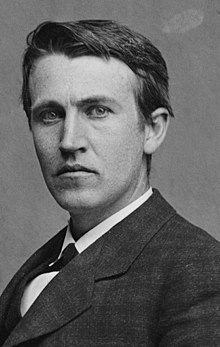

 " title="F200705240851336591321832 photo" border="0">
" title="F200705240851336591321832 photo" border="0">
